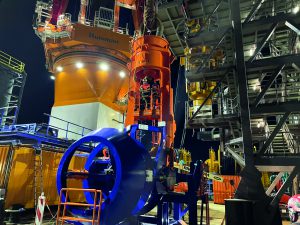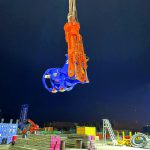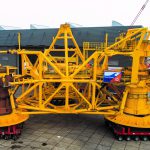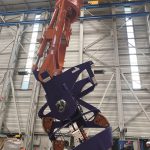Problem-solving capabilities
The construction of offshore wind farms requires a broad range of tools and equipment. As no wind farm project is the same due to, for example, soil, wind, and water conditions, each project often demands new tailor-made tools.
The French Saint-Brieuc offshore wind farm will be constructed off the Brittany coast. Van Oord is responsible for the transport and installation of 62 jacket foundations for the wind turbines (three pin piles each) and the four foundation pin piles for the offshore substation. Van Oord started the offshore operations early in 2021 with the installation of the 190 pin piles using its offshore installation vessel Aeolus. For this purpose, the vessel was upgraded and an extensive spread of project-specific installation equipment was engineered, constructed, and thoroughly tested to ensure a perfect execution of the project.
Casing Lift Adapter
For the offshore wind project, Dutch manufacturer Breman Machinery has been working on a challenging job in the past few months to engineer, construct, install, and test a new Casing Lifting Adapter. The CLA has a capacity of 308t and is a tailor-made tool dedicatedly constructed for this particular job. The CLA is designed to connect with a temporary casing used during drilling operations. It is equipped with redundant safety pin connections and it can be remotely operated. This is also one of the reasons why it has a sub-sea IP camera to provide real-time images during fitting operations. As the main contractor for the tool’s construction, Breman Machinery was responsible for the entire scope, from scratch to commissioning. In close cooperation with Kenc Engineering and Hycom, this resulted in a successful project. The construction of the tool took place at Breman Machinery’s first-class facilities in Genemuiden.
Horizontal load test
The CLA project is typical proof of Breman Machinery’s problem-solving capabilities. Albertus Vos, Project Manager of Breman Machinery, gives an example, “As the CLA was dedicatedly constructed for this specific job, it was necessary to conduct a load test to find out if the tool would be able to meet the required lifting capacity and could withstand any extra load that might appear during actual lifting operations at sea.” He continues, “The first idea raised was to perform the load test with mobile cranes, but due to the tool’s dimensions and weight, this was quickly discarded as it would require two very heavy cranes, resulting in considerable technical challenges and huge costs. Instead of this, the decision was made, together with Wagenborg/Nedlift, to use a horizontal test setup.” For this setup, a temporary test stand was constructed using lifting beams, steel valves, a lifting gantry, additional beams, and jacks. “Using horizontally positioned jacks,” Mr Vos explains, “would allow building up a tensile force on the adapter equal to the required tonnage. With load cells placed between the jacks and gantry beams, it was possible to accurately measure and record the tensile force. Finally, under supervision of DNV GL auditors, an accurately registered 387t load test of the LCA was successfully executed in two positions in early March.”
150 years
Next to the CLA, Breman Machinery also constructed a newly designed and created state-of-the-art piling template, which Van Oord will use as a positioning and holding-tool to ensure the precise placement of the pin piles. “Master craftsmen, solutions, and innovations have been in our DNA for the past 150 years,” states Henk Breman, CEO of Breman Machinery, “and we are a well-known manufacturing company for the offshore industry for many years now. Most of our projects for this market are one-offs. This requires a high level of flexibility and precision, no matter how small or big a work piece is.” “Once at sea, it is difficult to make adjustments to the equipment”, Mr Breman concludes. “Therefore, things need to fit perfectly. And apart from this, we know that the more accurately equipment is constructed, the longer it will last.”










